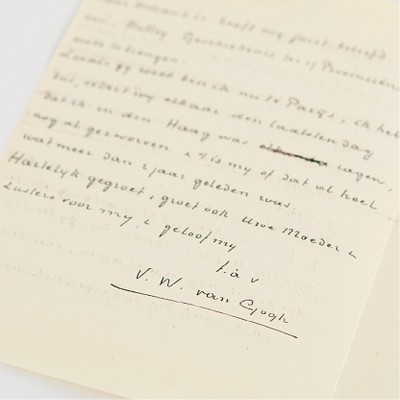Nikola Tesla Autograph Letter Signed
Two ways to bid:
- Leave a max absentee bid and the platform will bid on your behalf up to your maximum bid during the live auction.
- Bid live during the auction and your bids will be submitted real-time to the auctioneer.
Bid Increments
| Price | Bid Increment |
|---|---|
| $0 | $5 |
| $50 | $10 |
| $200 | $25 |
| $500 | $50 |
About Auction
Jun 15, 2022
RR Auction's June Fine Autograph and Artifact sale brings over 800 extraordinary items to the auction block, including: a four-page musical manuscript by Wolfgang Amadeus Mozart, containing four canons and an early autograph letter signed by the celebrated painter Vincent van Gogh. RR Auction support@rrauction.com
- Lot Description
ALS signed “N. Tesla,” four pages on two adjoining sheets, 5.75 x 6.75, personal monogram letterhead, May 18, 1899. Handwritten letter to Rear Admiral Francis J. Higginson by Nikola Tesla, from the Alta Vista Hotel in Colorado Springs, in part: "My coming here was necessary because I wanted to obtain some data in high altitudes in view of my attempt to communicate with and possibly to transmit energy to Europe. These data though they are for a different purpose will also be useful in telegraphy. The work here will keep me working three to four weeks, but on my return I shall immediately devote as much of my time as possible to the task of establishing a thoroughly satisfactory and reliable communication with the lightship." In very good to fine condition, with light staining to the right side.
In May, Higginson had written to Tesla on the subject of wireless telegraphy, asking if he would be able to develop a system to be deployed on Light-Vessel No. 66, Nantucket Shoals, Mass., lying about 60 miles south of Nantucket Island. At the time, Tesla had patents pending on basic radio technologies, which would be granted in 1900. In spite of Tesla's initial interest, the plan would not come to fruition—the Navy refused to finance the project, and also found Tesla rather difficult to work with. Higginson continued to advocate for wireless communications technology within the government, and in 1901 Marconi wireless telegraph equipment was 'temporarily and experimentally installed' on the Nantucket lightship. In 1904, it would become the first US lightship to be permanently equipped with radio—though not of Tesla's design.
Nikola Tesla had arrived in Colorado Springs earlier in May, and he spent the summer conducting experiments related to both wireless telegraphy and power transmission. It was during this period that he reported hearing unusual, rhythmic sounds from his receiver. In a letter to Julian Hawthorne, Tesla contended that these signals were evidence that 'intelligent beings on a neighboring planet' must be scientifically more advanced than Earthlings. It has since been hypothesized that Tesla may have intercepted Marconi's European experiments in July 1899—Marconi may have transmitted the letter S (dot/dot/dot) in a naval demonstration, the same three impulses that Tesla hinted at hearing in Colorado—or signals from another early experimenter in wireless transmission. In any event, this is a significant handwritten letter by Nikola Tesla, written during one of his most influential and productive periods of experimentation. - Shipping Info
-
Bidder is liable for shipping and handling and providing accurate information as to shipping or delivery locations and arranging for such. RR Auction is unable to combine purchases from other auctions or affiliates into one package for shipping purposes. Lots won will be shipped in a commercially reasonable time after payment in good funds for the merchandise and the shipping fees are received or credit extended, except when third-party shipment occurs. Bidder agrees that service and handling charges related to shipping items which are not pre-paid may be charged to a credit card on file with RR Auction. Successful international Bidders shall provide written shipping instructions, including specified Customs declarations, to RR Auction for any lots to be delivered outside of the United States. NOTE: Declaration value shall be the item’(s) hammer price and RR Auction shall use the correct harmonized code for the lot. Domestic Bidders on lots designated for third-party shipment must designate the common carrier, accept risk of loss, and prepay shipping costs.
-
- Buyer's Premium



 EUR
EUR CAD
CAD AUD
AUD GBP
GBP MXN
MXN HKD
HKD CNY
CNY MYR
MYR SEK
SEK SGD
SGD CHF
CHF THB
THB













